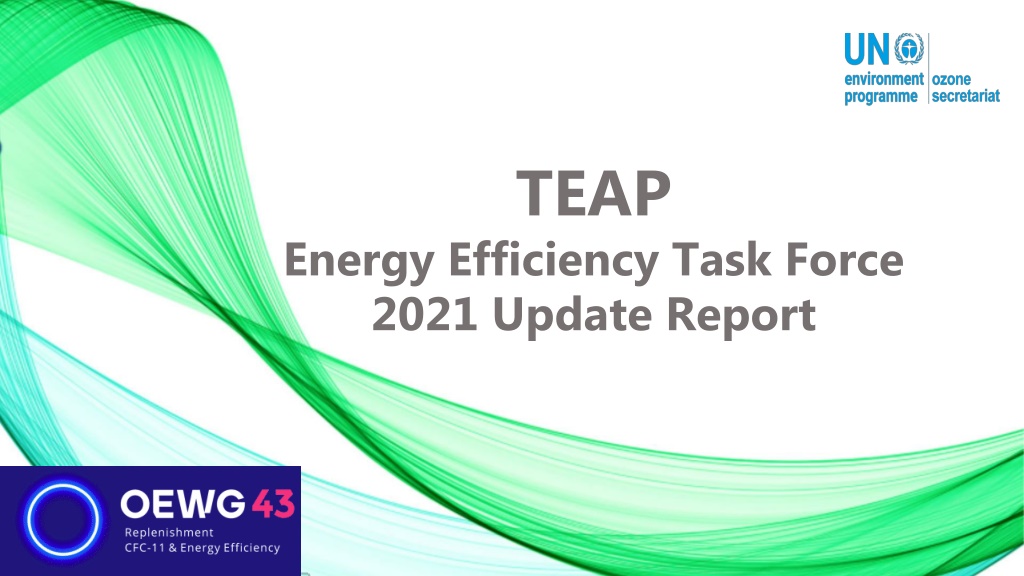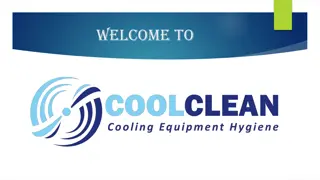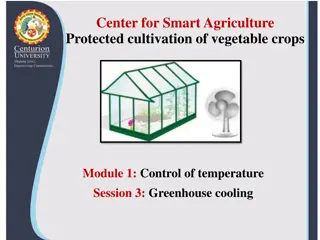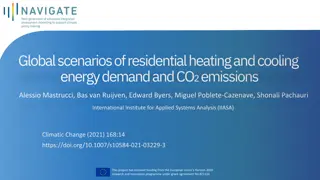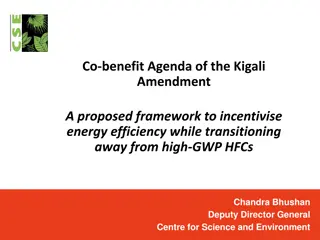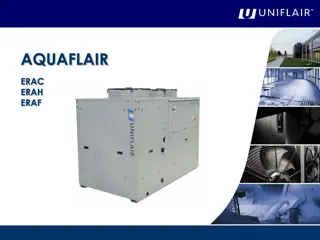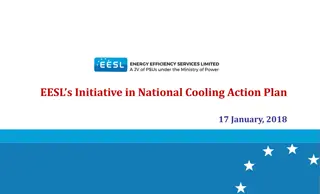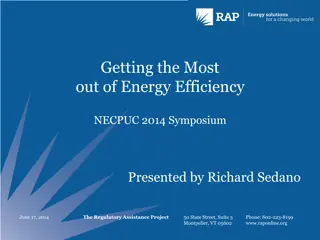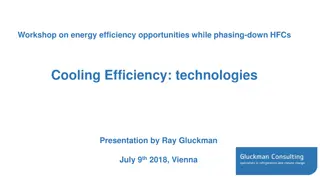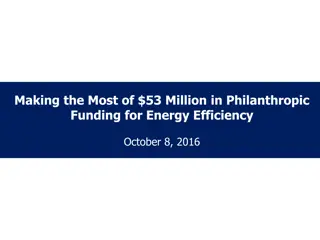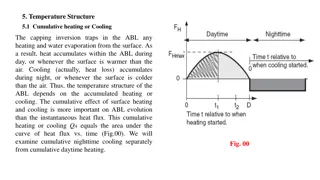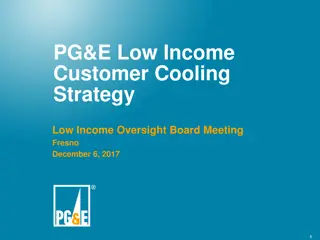Addressing Energy Efficiency in Cooling Sector: 2021 Report Highlights
The 2021 update report from the TEAP Energy Efficiency Task Force emphasizes the critical nature of the climate emergency and the need to transition to lower GWP refrigerants and higher efficiency cooling systems. The report focuses on initiatives to enhance the efficiency of room ACs and refrigerators, leveraging experience from the Montreal Protocol. Decision XXXI/7 calls for continued efforts in providing information on energy-efficient technologies, with a specific focus on the refrigeration, air conditioning, and heat pump sectors. The Energy Efficiency Task Force, comprising members from various countries, has been actively working on enhancing energy efficiency in the cooling sector, with a particular emphasis on room ACs and self-contained commercial refrigeration equipment.
Download Presentation

Please find below an Image/Link to download the presentation.
The content on the website is provided AS IS for your information and personal use only. It may not be sold, licensed, or shared on other websites without obtaining consent from the author. Download presentation by click this link. If you encounter any issues during the download, it is possible that the publisher has removed the file from their server.
E N D
Presentation Transcript
Online Forum TEAP Energy Efficiency Task Force 2021 Update Report Online Forum
Online Forum Chapter 1 Introduction H l ne Rochat Online Forum
A Climate Emergency The climate emergency is the defining issue of our time .UN Secretary General Ant nio Guterres, 23 February 2021, Remarks to the Security Council Reports from TEAP, UNEP, IEA, K-CEP, CCAC all emphasise opportunity to mitigate global warming from a coordinated transition to lower GWP refrigerants and higher efficiency cooling UNFCCC COP-26 will capitalise on progress with Montreal Protocol/Kigali Amendment Five themes address cooling Initiative to double efficiency of Room AC and Refrigerators Cites Montreal Protocol as opportunity to work collaboratively and leverage experience with cooling sector Online Forum 3
Decision XXXI/7 : Continued provision of information on energy-efficient and low global-warming-potential technologies. 31st Meeting of the Parties, Rome 2019 To request the Technology and Economic Assessment Panel to prepare a report for consideration by the Thirty-Second Meeting of the Parties addressing any new developments with respect to best practices, availability, accessibility and cost of energy-efficient technologies in the refrigeration, air-conditioning and heat-pump sectors as regards the implementation of the Kigali Amendment to the Montreal Protocol . Online Forum 4
Decision XXXI/7 Energy Efficiency Task Force (EETF) Roberto Peixoto, Co-chair BRA Alex Hillbrand US 26 members/2 consulting experts 16 A5: 12 non-A5 All work completed online Focus on Room AC and Self-contained commercial refrigeration equipment (SCCRE) 2020 Initial report - September 2020; discussion scheduled for Nov 2020 deferred 2021 Update report - May 2021. Additional work including new modelling Helene Rochat, Co-chair CH Mary Koban US Ashley Woodcock, Co-chair UK Satish Kumar IN Omar Abdelaziz EG Ashraf Kraidy EG Kofi Agyarko GH Stephen Kujak US Thamir Alshehri SA Kevin Lane UK Jitendra Bhambure IN Tingxun Li CN Ana Maria Carreno CO Richard Lord US Hilde Dhont BE Pablo Moreno MX Gabrielle Dreyfus US Rose Mutiso KE Bassam Elassaad LB Tetsuji Okada JP Ray Gluckman UK Oswaldo dos Santos Lucon BR Herlin Herlianika ID Nihar Shah IN Consulting Experts US Brian Holuj Gottfried Huber DE Online Forum 5
TEAP Reports on Energy Efficiency during HFC phasedown, following adoption of Kigali Amendment Parties adopted a series of Decisions on Energy Efficiency (EE) at Meetings of the Parties: 2016 - Decision XXVIII/3 2017 - Decision XXIX/10 2018 - Decision XXX/5 2019 - Decision XXXI/7 TEAP has responded by providing reports in the following years. TEAP Working Group 2017 Energy Efficiency Task Force Reports in 2018 and 2019. Energy Efficiency Task Force Report 2020; Updated in 2021 Online Forum 6
TEAP Reports 2017, 2018, 2019, 2020 Key Messages Cooling essential for UN Sustainable Development Goals; but is creating a vicious circle between demand for cooling, direct/indirect CO2 emissions, and global warming Many EE technical innovations in RACHP with lower GWP refrigerants available, and increasingly accessible Possible to leapfrog from HCFCs directly to lower GWP refrigerants in higher EE equipment MEPS without HFC phasedown in some A5 parties, result in continued use of high GWP refrigerants. Equipment-receiving A5 parties with no or low MEPS only have access to low EE/ high GWP imported RACHP equipment Excess power demand substantial long-term economic disadvantage. Additional financing from multilateral organisations could deliver EE gains during HFC phase-down in A5 parties. Synergies with Energy Efficiency (EE) during HFC phase-down could double the climate benefit Online Forum 7
Developments in Cooling, HFCs, Energy efficiency Market estimated $135 billion/year 2019 $185 Billion by 2030 Using fossil fuels to meet energy demand to keep cool is unsustainable Decarbonisation of electricity; Energy Efficient buildings; stronger regulations based on seasonal performance; HFC phasedown; - all critically important and synergistic CLASP A5 parties which lack MEPS import high GWP/low EE AC long term burden Adoption of best technologies would: Reduce climate emissions by 130-260Gt CO2eq over 2030-2050 (25% HFCs; 75% reduced electricity) Avoid $3 trillion in energy/operating costs by 2050 Reduce energy needs by 20% Online Forum 8
Online Forum Chapter 2 2021 Update on Lower GWP Refrigerants with Energy Efficiency Technologies Omar Abdelaziz Online Forum
2021 Update on Lower GWP Refrigerants with Energy Efficiency Technologies Equipment energy efficiency (EE) can be improved using advanced technologies Sensors and controls to optimize performance and minimize energy consumption Cost-effective variable speed drives Condenser precooling Possible to leapfrog from HCFCs directly to lower GWP options whilst maintaining/enhancing EE Coordinating EE with HCFC phase-out and HFC phase-down enables industry to Explore the synergies related to redesigning equipment Retool manufacturing lines The unique in-depth knowledge of RACHP sector held within the Montreal Protocol family can strongly support the combined reduction of direct and indirect GHG emissions Online Forum 10
Developments in EE Technologies for Room AC Occupancy sensors can detect the number/location/activity of people and adjust performance Controlling temperature and humidity independently allows for optimized comfort will improving equipment EE The internet control of AC through algorithms that improve comfort, usability, safety, and performance Condenser precooling: Using the condensate leaving the evaporator coil (or fresh water) to reduce the air temperature entering the condenser by up to 7 C, can result in up to 20% EE improvement Variable Speed Drive (VSD) technology maturity Cost reduction Widespread adoption Online Forum 11
Incremental Costs for manufacturing conversion: Energy Efficiency and Low GWP Refrigerants Room AC manufacturing conversion in Saudi Arabia with leapfrog from HCFC-22 HC-290: ICC for flammable refrigerants ~ 600k USD IOC for more expensive compressor for hydrocarbons, but incidental greater EE For commercial refrigeration ICC related to flammable refrigerant conversion varied from 200k to 2M USD while ICC related to EE improvement varied from 3k USD to 50k USD IOC related to flammable refrigerant conversion varied from 2-34 USD per unit while IOC related to EE varied from 1 to 55 USD per unit with EE gain varying from 4 to 33% (ICC Incremental Capital Cost; IOC Incremental Operating Cost) Online Forum 12
Safety barriers for Energy Efficiency Improvement using Lower GWP Refrigerant Lack of harmonization between the different standards bodies Lack of strong regulatory and market signal Flammable refrigerant charge constraints limit EE improvements HC refrigerants require larger compressors and heat exchangers resulting in higher cost Room AC manufacturers, local distributors, installers and decommissioners in A5 parties have to develop the skills of technicians for safe installation and servicing of A3 and A2 refrigerants, with additional cost compared to A1 and A2L refrigerants Need for implementation of Worldwide Technician Certification Schemes to reduce leakage and improve safety Online Forum 13
Some technical challenges for EE Improvement using Lower GWP Refrigerant Microchannel Heat Exchangers: reliability issues in coastal and polluted areas on-site repair difficulty lack of trained welders challenges with condensate removal and defrosting Larger airflow rates improve EE, but at the cost of reduced comfort and/or increase noise Larger heat exchange surfaces improve EE, but at the cost of larger equipment sizes which in practice limit installation Online Forum 14
Online Forum Chapter 3 Availability & Accessibility Bassam Elassaad Online Forum
Availability Availability Decision XXXIX/10 and XXX/5: Low GWP, high EE equipment available even at 10% over average MEPS for residential AC and SCCRE Components also available in most regions Questions raised about accessibility to technology by manufacturers and to products by end users. Access to high EE / lower GWP products is improving, although it remains limited in many A5 parties and even in some non-A5 parties. Online Forum 16
Availability from a local manufacturing Availability from a local manufacturing point of view point of view Equipment receivers vs. equipment producers is linked to consumption (parties' classification) local manufacturing is driven by the size of the market. scale impacts the absorption of high efficiency technologies Manufacturers need to be able to build their technical capabilities in order to absorb the new technologies. Patents may not be an issue for manufacturers with established R&D some remaining barriers need to be addressed Online Forum 17
Best available Room ACs Best available Room ACs Currently, the best available Room AC have a SEER around 2.5 times better than the lowest efficiency and substantially higher than the market average Online Forum 18
Factors affecting accessibility Supply chain Local vs. import Regulatory MEPS and Labels: effect on best-in-class availability Trade policy: bans on obsolete products Affordability Payback, solutions to first cost barriers (Cooling as a Service), Life Cycle Cost Serviceability Use limitations: Practicality of design, example size Trained service technician capacity, example RDL Spare parts and refrigerants: whose responsibility? Quality of power supply & logistics: weakening value proposition Online Forum 19
Removing barriers Removing barriers For equipment receivers: Increasing awareness, training, and enforcement For equipment producers: Support for technology transfer Market intervention is required to move from an old established approach to new technologies Funding the improvement of demand-side efficiency reduces electricity demand and saves building power plants As volumes increase, the cost of more efficient equipment is decreasing even as EE standards are increasing Online Forum 20
Online Forum Chapter 4 Synthesis of Case Studies Illustrating Developments with Respect to Best Practices Gabrielle Dreyfus Online Forum
Synthesis of Case Studies Illustrating Developments with Synthesis of Case Studies Illustrating Developments with Respect to Best Practices Respect to Best Practices Key messages based on the 27 case studies collected by the EETF: Coordination between energy efficiency officials and ozone officers facilitates transition to lower GWP and higher EE equipment Ambitious synergistic HCFC phase-out and HFC phase-down policies with progressive EE improvement would benefit parties Avoiding the build-up of large installed base of low EE equipment protects against economic disadvantage that could last for decades due to the long lifetimes of cooling equipment Developing and enforcing policies and regulations to avoid the market penetration of low efficiency RACHP equipment could stop environmentally harmful dumping Online Forum 22
Annex I: Case Studies Annex I: Case Studies 1. Institutional Arrangements & National Cooling Plans 1.1 Institutional Arrangements in Ghana 1.2 India Cooling Action Plan 1.3 China Green and High-Efficiency Cooling Action Plan 1.4 National Cooling Action Plans 1.5 Rwanda National Cooling Strategy 1.6 Mexico Roadmap to Implement the Kigali Amendment 1.7 National Cooling Action Plan Methodology 1.8 Cooling in the context of COP26 and updated Nationally Determined Contributions (NDCs) 2. National and regional capacity building 2.1 Twinning Workshop 2.2 Prohibition on importation of used refrigerators and used ACs 2.3 Product Registration Systems in ASEAN Region 3. Supply Chain & Skilled Workforce (Installation, Maintenance & Servicing) 3.1 Effect of good service and maintenance on energy efficiency 3.2 Argentina s Experience Creating a Training Framework for RACHP Technicians 3.3 Case Study: Landscape of the Air Conditioning Market in Brazil 3.4 Case study on installation and servicing (A2L and A3 alternatives) in India for better accessibility 3.5 Accessibility of chest freezers and ACs in tier 3 and tier 4 cities 4. Regulatory Environment 4.1 United for Efficiency (U4E) Model Regulations 4.2 Energy efficiency metrics for air conditioners and impact on the product development 4.3 Kenya AC MEPS update 4.4 Case Study: Brazilian new national labeling for energy efficiency of Air Conditioners 4.5 EU Ecodesign and GWP bonus 4.6 Indian 24 C mandatory default setting 4.7 Integrating GWP into EE labels 5. Market-pull policies 5.1 Global Cooling Prize 5.2 Rebate/replacement programme for low GWP energy efficient plug-in commercial refrigeration appliances. 5.3 Bulk purchase of commercial plug-in 5.4 Demonstration project of HFC conversion by hydrocarbons as a coolant in manufacturing domestic refrigerators in Mexico Case studies were compiled from the diverse membership of EETF with consideration for geography, policy type, and equipment type to provide a diversity of examples Online Forum 23
Case Study: Global Cooling Prize Case Study: Global Cooling Prize The Global Cooling Prize awarded in April 2021, showed that it is technically and economically feasible with innovative design in room air conditioners to achieve potentially 5 times lower climate impact with a cost that is about twice that of the baseline technology when manufactured at scale. Winning teams used higher performance components, low-or-ultralow GWP refrigerants (HFC-152a, and HFO-1234zeE), variable speed compressors, condenser evaporative precooling, free-cooling, effective renewable energy integration, and advanced controls to sense temperature and humidity independently for effective cooling load management. Other solutions included barocaloric cooling using organic solid crystals, evaporative cooling, membrane-based dehumidification, and desiccant dehumidification. Online Forum 24
Case Study: Integrating GWP and EE in Standards/Labels Case Study: Integrating GWP and EE in Standards/Labels Brazil: new mandatory INMETRO label aiming to raise the level of energy efficiency levels and new voluntary PROCEL Gold Label supporting criteria for EE and refrigerant. To be awarded the PROCEL gold label, the AC product must simultaneously meet SEER, ODP and GWP requirements: U4E Model Regulations: guidelines for room AC/HP, residential refrigerators, and commercial refrigeration (in process) set minimum requirements so that new products are energy-efficient and use refrigerants with a lower global warming potential (GWP) than typical legacy refrigerants. They also propose the ban of imported used products and regular revision to ensure that policies keep up with evolution in the cost and availability of new technologies. Applicable Dates From 2022-05-03 From 2023-11-03 ODP 0 0 GWP 2088 750 Online Forum 25
Online Forum Chapter 5 Modelling the Benefits Enhancing Energy Efficiency while Phasing Down HFCs Ray Gluckman Online Forum
Good Modelling Informs Policy At country level For the development of Kigali HFC Implementation Plans (KIPs) For Montreal Protocol Technical Committees (e.g. TEAP, RTOC etc.) For Task Force and Assessment Reports Modelling provides valuable insights to support Kigali Amendment implementation Better understanding of complex markets Comparison of different HFC phase-down trajectories Assessment of actions that reduce HFC and energy consumption and emissions Understanding the potential to improve EE in combination with HFC phase-down Online Forum
Modelling of GHG Emissions from RACHP A comprehensive stock model Must include the wide range of RACHP sectors and sub-sectors Modelling of all relevant HFC Mitigation Activities 1. Gas choices in new equipment 2. Leakage reduction 3. End-of-life gas recovery and re-use 4. Retrofit of high GWP gases Modelling of all relevant Energy Mitigation Activities 1. High EE new equipment (e.g. via MEPS and energy labels) 2. Cooling load reduction 3. Improved operation, control and maintenance 4. Use of decarbonised electricity Online Forum
Example Modelling Outputs The following slides are outputs from the HFC + Energy Outlook Model Developed by EPEE with support from UNEP To date, models have been developed for 10 Article 5 countries Online Forum
Example 1: HFC Phase-down Trajectories and Kigali Phase-down Steps (A5 Group 1) 4 HFC phase-down scenarios based on different mitigation actions Online Forum
Example 1: HFC Phase-down Trajectories and Kigali Phase-down Steps (A5 Group 1) Cumulative Emissions 2020 to 2050 illustrate benefits of early action Some urgency to start HFC phase-down Total Baseline (in freeze period) actions Reference Scenario Just Compliant Best Possible 100 50 25 HFC Kigali Phase-down Steps Component of Baseline HCFC Component of Baseline Online Forum
Example 2: Forecast of Potential Energy Related GHG Emission Reductions from RACHP market Online Forum
Example 3: Forecast of Gas and Energy Emission Reductions Online Forum
The Importance of Heat Pumps The RACHP stock model used in the above example includes 2 types of heat pump Reversible air-conditioning units that can cool in summer and heat in winter e.g. air-to-air systems like the room air-conditioning units in EETF analysis Units used primarily to provide space heating or process heating e.g. air-to-water systems heating a house with hot water radiators The modelling of these heat pumps includes GHG emissions from Refrigerant leakage Electricity used It is important to also model the heat pump GHG benefits They are intended to help decarbonise heating systems Online Forum 34
Example 4: The Impact Of Heat Pumps The RACHP energy and gas emissions include heat pumps By 2050, the fossil fuel emissions avoided are >10 times higher than total RACHP emissions Online Forum
Key Messages from Modelling Energy related GHG emissions are around 70% of total emissions from RACHP There is excellent potential to simultaneously reduce both refrigerant and energy related emissions Early action can halve total cumulative emissions between now and 2050 Use of heat pumps can create large reductions in fossil fuel emissions Good models help planning the best phase-down policies Online Forum 36
Online Forum Chapter 6 A draft framework for outputs from previous TEAP and EETF Reports Roberto Peixoto Online Forum
Framework Proposal TEAP EETF reports have compiled information on: Refrigerant and technology options, costs, availability, accessibility, and best practices, relevant funding agencies. for maintaining and/or enhancing energy efficiency in refrigeration, air-conditioning and heat pump (RACHP) sectors while phasing down HFCs under the Kigali Amendment The EETF has proposed a draft framework to catalogue the diverse and extensive information that has been compiled in these reports Objective: to assist Parties understanding by considering options related to capacity-building, servicing sector, manufacturing (assembly and component) and not-in-kind alternatives Online Forum
Framework Proposal Funding: TEAP EETF 2018 report has reviewed funding institutions related to EE. This review and other studies show that the framework for funding mechanisms and procedures is influenced by the scale of the funding portfolio. Estimating the scale and scope of such a portfolio and project pipeline could inform the options for co-financing arrangements The MP community, including TEAP, MLF and Implementing Agencies, have the unique ability to estimate the potential conversions, supporting policies and enabling activities that would be involved in a synchronized transition to low- GWP alternatives while maintaining or enhancing EE. Online Forum
Online Forum Conclusion Ashley Woodcock Online Forum
Context for EETF Report Parties took Decision XXXI/7 on Energy Efficiency in Rome in Nov 2019 No Party discussions in 2020; Parties will discuss virtually in July, October 2021; Possible that first face-to-face discussions could be delayed until July 2022 OEWG Meanwhile Technology and Market developments are continuing Accessibility improving Better understanding of the synergy between HFC phasedown and Energy Efficiency As world economy recovers after the pandemic, there is an opportunity for a green recovery EETF has maintained momentum to provide an update report for the July 2021 OEWG containing additional policy-relevant information, and new modelling Online Forum
Executive Summary: Near-term questions for the consideration of parties How to: Facilitate the collaboration between Ozone and Energy Departments? Encourage the implementation of integrated regulations for Energy Efficiency during HFC phasedown? Improve the accessibility to lower GWP/high EE RACHP equipment? Prevent dumping of high GWP/low EE RACHP equipment into equipment receiving A5 parties, to avoid substantial long term disadvantages? Assist parties who wish to adopt a fast mover status with synergistic HCFC phase-out/HFC phase-down with progressive improvement in energy efficiency? Online Forum 42
If requested TEAP could: Expand the work on modelling to assess the benefits of the integration of energy efficiency and HFC phase-down measures on a regional and global basis. Further develop a framework to catalogue the information from five TEAP/EETF reports, and from other sources including the Multilateral Fund and Implementing Agencies, in order to assist parties as they move forward to operationalise the Kigali Amendment Evaluate scenarios to curb the growth of high GWP HFCs, while integrating energy efficiency Online Forum
Meeting the Kigali Challenge Demand for cooling is increasing rapidly, which is leading to increasing global warming from both direct and indirect emissions Time is short with risk of inaction linked to delays through the pandemic The Montreal Protocol has already recognised the need to improve the energy efficiency of RACHP equipment during the phase-down of high GWP refrigerants As efficient cooling gains traction at UNFCCC COP-26, there will be substantial interest in the synergies between EE and the HFC phase-down under the Montreal Protocol The in-depth knowledge of RACHP sector held within the wide Montreal Protocol family can uniquely enable a combined reduction of both direct and indirect GHG emissions Online Forum 44
